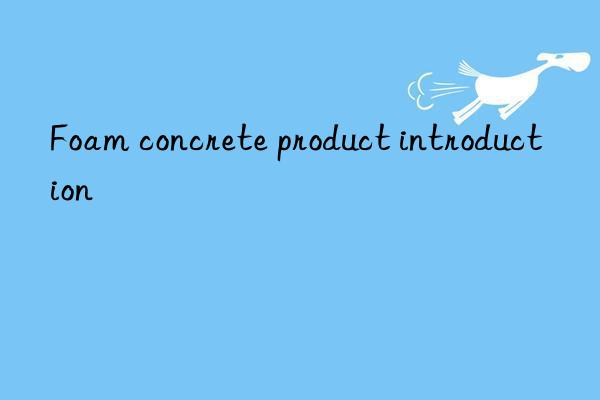
Foam concrete is also called foamed concrete and lightweight concrete. Our company introduces German technology and production technology and specializes in the production of TB multi-functional foam concrete. It is an early manufacturer of foaming agents in Anhui. The on-site foam concrete construction and good services have won unanimous praise from owners, supervisors and construction units. The factory has multiple sets of domestically advanced foam concrete machinery and equipment, with a daily output of 100M3 per equipment, and a floor heating insulation layer construction capacity of 1500-2000M2 per day.
Foamed concrete is the youngest member of the concrete family. It is made of Portland cement (or sulfate cement, magnesium oxychloride cement), activated silicon or calcium materials (such as cement ash, Microporous polymer lightweight concrete is formed by mixing the foam generated by inorganic binders such as diatomaceous earth) with a high-efficiency foaming agent that integrates foaming, stabilizing, stimulating and water-reducing functions. After the concrete is finally set, the bubbles form a large number of independently closed homogeneous micropores, forming a honeycomb structure, which greatly reduces the volume density and thermal conductivity, and effectively improves the thermal resistance and sound insulation performance.
Foamed concrete has been widely used abroad. Our country is paying more and more attention to building energy conservation. Foamed concrete will be more and more widely used due to its excellent characteristics.
Product series include: TB inorganic active wall insulation system, TB foaming agent, inorganic foam board, bonding mortar, waterproof mortar, fireproof mortar, special flexible putty for external insulation, tile adhesive, Colored tile caulking agent, wear-resistant floor mortar, self-leveling mortar, colored facing mortar, concrete interface agent, wall renovation putty, flexible waterproof mortar, rigid waterproof mortar, inorganic shrinkage grout.
Performance characteristics of TB foam concrete
Lightweight and high-strength foam concrete has a bulk density of 300-1000kg/m3, ordinary concrete 2000-2200kg/m3, ceramsite concrete 1300-1500kg/m3, foam concrete Obviously lightweight, it can effectively reduce the dead load of the building and optimize the structural design. It has high strength among lightweight materials (it can be used by people in 2-3 days), which is beneficial for cutting exhaust grooves.
Thermal insulation The thermal conductivity of ordinary concrete is ≤1.28w/m.k, the thermal conductivity of ceramsite concrete is 0.2-0.6 w/m.k, the thermal conductivity of cement ash air-entrained block is 0.18-0.35 w/m.k, and the thermal conductivity of foam concrete 0.065-0.21 w/m.k, which has obvious advantages in thermal insulation.
Good constructability: MFC foam concrete is constructed using on-site mixing and pumping, integral pouring, one-time molding, mechanized construction, high work efficiency, and conducive to shortening the construction period.
High cost performance: Roof construction can "combine the leveling layer, slope layer, and insulation layer into one", which reduces the cost by 20% compared with ceramsite concrete slope extruded board insulation, and is lower than the insulation mortar slope. More than 10%.
Low shrinkage rate. Due to its honeycomb structure and natural curing, foam concrete has a very low shrinkage rate and a small expansion coefficient. It has a "soft cushion" property against external forces and is not easily damaged.
Good sound insulation effect
The sound absorption capacity of a large number of independent bubbles in foam concrete reaches 0.09% to 19%, which is 5 times that of ordinary concrete. It has good sound insulation effect when used as floor sound insulation material. .
Long service life, strong aging resistance, the same service life as the main building, and a shelf life of 50 years. High fireproof performance, Class A fireproof, no deformation when exposed to heat. </p



 微信扫一扫打赏
微信扫一扫打赏
